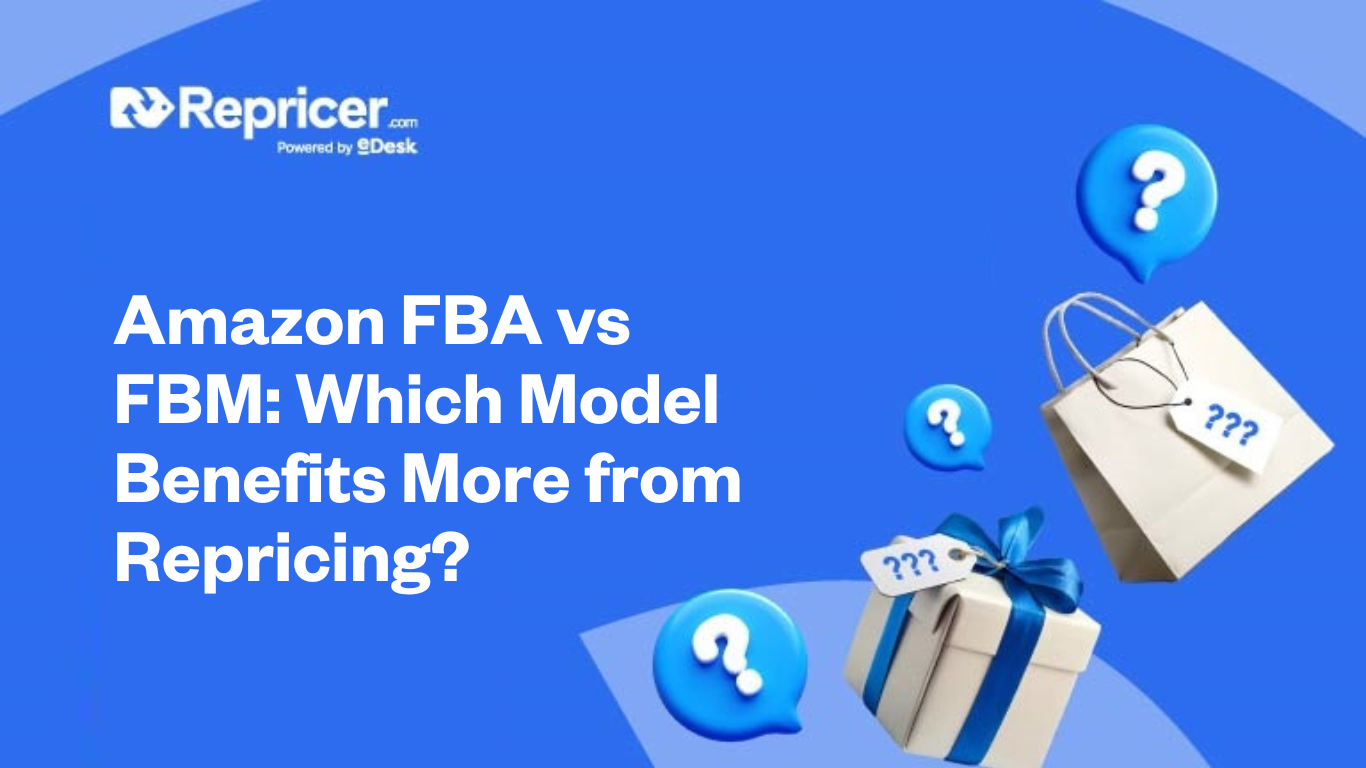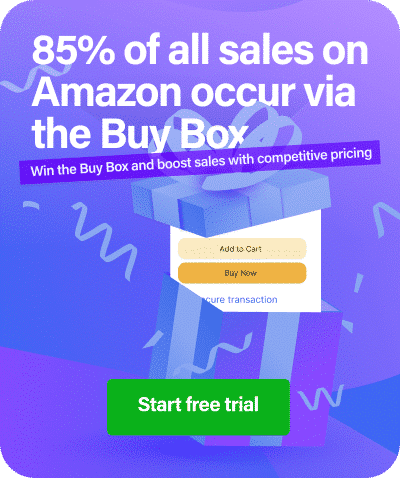You’ve got the products. You’ve got the ambition. Now you’ve got a choice to make: FBA vs FBM, and should you reprice differently based on which option you choose?
Because choosing between Fulfilled by Amazon (FBA) and Fulfilled by Merchant (FBM) isn’t purely about how you ship a parcel. It changes how you run your business, what you pay, and how you compete for the Buy Box. And crucially, it affects how you should think about pricing.
Whichever route you take, using a repricing tool gives you more control over your profits, your visibility, and your ability to scale. If you’re still on the fence, it’s worth understanding the benefits of using an Amazon repricer to see how sellers stay ahead with automation.
So, which model works better with repricing tools? And what do you need to do differently depending on the path you choose?
Let’s break it down.
What’s the difference between FBA and FBM?
Here’s the short version.
With FBA, Amazon stores, packs, and ships your products. You send inventory to Amazon’s warehouse, and they take it from there. You pay fees, but your items are Prime-eligible, and you get that famous fast shipping.
With FBM, it’s all on you. You handle the storage, packing, and shipping yourself, or you get a third-party logistics provider to do it. You might not get the Prime badge unless you qualify for Seller Fulfilled Prime (SFP), but you keep tighter control over costs and stock.
That’s FBA vs FBM in a nutshell. Both models have their strengths…and trade-offs. And that’s where pricing strategy becomes key.
Why your fulfilment method changes your pricing approach
Your fulfilment model directly affects your costs, shipping time, and perceived trustworthiness. All three impact how you should price.
For FBA sellers, the Prime badge alone can justify slightly higher prices. Buyers trust it, and many filter results to show Prime items only. You’re also more likely to win the Buy Box, even if you’re not the cheapest.
But those perks come at a cost. FBA sellers pay storage fees, fulfilment fees, and potentially long-term storage penalties if items don’t shift. That means margins are tighter, and your repricing needs to take that into account.
FBM sellers often have lower fixed costs and more flexibility. But without the Prime badge, you’re competing harder on price and shipping promises. That makes dynamic pricing and smart repricing even more important.
The real impact of repricing in an Amazon FBA business
Repricing is powerful in any model, but in FBA it plays a very specific role.
Here’s why. When you’re using FBA, you’re already halfway to Buy Box success. Amazon favors Prime-eligible listings, so even if your price isn’t the lowest, you might still land the sale.
But that doesn’t mean you can set and forget. You still need to stay competitive, especially if lots of other sellers are also using FBA. Repricing helps you stay just low enough to secure the Buy Box without slicing into your profit.
Smart repricing tools can also factor in your FBA fees. That helps you avoid racing to the bottom. Instead, you can set minimum price thresholds based on actual margins, not guesswork.
And here’s a hidden win: rule-based repricing can help you shift stale FBA stock before those storage fees start eating into your margins. So if you’re looking to control inventory storage costs, automation can do more than just save time.
Repricing for FBM: it’s a different ball game
If you’re handling your own fulfilment, repricing works a little differently.
FBM sellers don’t always get the same visibility or trust that FBA sellers enjoy. So when a customer compares a FBA listing with a FBM listing, you often have to work harder to compete.
That usually means sharper pricing. Repricing helps you adjust quickly when competitors drop their prices, so you don’t miss out on sales.
But there’s a silver lining. FBM sellers usually have tighter pricing control. If your storage or fulfilment setup is lean, you’ve got more wiggle room to price competitively and still make money.
You can use your repricing strategy to highlight other strengths, like faster dispatch times or better customer feedback. Even without the Prime badge, those factors, combined with sharp pricing, help you stay competitive. Some sellers use repricing strategies to position premium FBM listings as better-value options than low-cost FBA competitors.
What about Seller Fulfilled Prime?
Seller Fulfilled Prime (SFP) sits somewhere in the middle.
You handle your own storage and shipping, but your listings show the Prime badge, as long as you meet strict standards for delivery speed, tracking, and service.
In theory, it gives you the best of both worlds. You avoid FBA fees, but still benefit from Prime visibility.
But in practice, SFP is hard to qualify for and even harder to maintain. It’s currently closed to new enrolments in many regions, and Amazon expects perfection from SFP sellers.
If you’re in, great. Repricing with SFP in mind means you can take a similar approach to FBA sellers, leaning on your Prime status while protecting your margin.
If you’re not, it’s probably better to focus on making FBM work well through pricing, service, and fulfilment speed.
Key repricing considerations for FBA sellers
Here’s what to focus on if you’re running an Amazon FBA business:
1. Include fees in your minimum prices.
Your storage and fulfilment costs can eat into margins fast. Make sure your repricing strategy includes those in your calculations.
2. Use automation to shift slow stock.
Don’t let stale inventory sit. Create rules that automatically lower prices on items approaching long-term storage fees.
3. Don’t panic if you’re not the cheapest.
FBA sellers often win the Buy Box at higher prices. Use repricing to stay competitive, not just cheap.
4. Keep an eye on seasonal storage costs.
Peak seasons like Q4 bring higher storage fees. Plan your pricing ahead of time to move stock quickly.
5. Monitor competitor fulfilment types.
If you’re competing with FBM sellers, you might not need to match their low prices to win the sale.
Key repricing considerations for FBM sellers
For FBM sellers, the approach is different but just as strategic:
1. Price aggressively where needed.
You might need to undercut FBA listings slightly to win attention, especially without Prime.
2. Highlight fast shipping or good reviews.
Your price isn’t the only selling point. Combine competitive pricing with great customer experience.
3. Factor in your own shipping costs.
Repricing should account for how much it actually costs you to ship, including packaging and handling.
4. Use smart rules for different SKUs.
Some products sell well without needing to be the cheapest. Others need sharper pricing. Tailor your rules accordingly.
5. Watch out for race-to-the-bottom traps.
Just because an FBA seller drops their price doesn’t mean you should follow blindly. Stick to your minimums.
Who benefits more from repricing: FBA or FBM?
Here’s the honest answer: both do. But for different reasons.
FBA sellers benefit from repricing because they’re often in closer competition with other Prime listings. Even small price differences can make a big impact on Buy Box share.
FBM sellers benefit because repricing helps them stay nimble. They can respond quickly to changes in the market, drop prices to outmanoeuvre FBA listings, or raise prices when competition thins out.
The biggest difference is how you use the tool. FBA sellers often reprice to defend profit. FBM sellers often reprice to boost visibility.
Neither model is better. But the winners are always the ones using pricing as a strategy, not an afterthought.
You don’t need to choose between speed and control
Let’s say you’re thinking of trying both models. Many sellers do.
Maybe you use FBA for your bestsellers and FBM for niche or oversized items. Or you switch between them based on season or stock levels.
In that case, your repricing tool needs to be smart enough to handle both. You want to set different rules based on fulfilment type, because pricing an FBA item the same way as an FBM one makes no sense.
That’s where rule-based automation makes a real difference. You can define different minimum prices, competitor types, and repricing behaviour depending on how the product is fulfilled.
That means less manual work for you, and more consistent margins across your catalogue.
If you’re looking for the right tool to manage all that, here’s where Repricer comes in.
Your next move? Turn fulfilment rules into pricing power
You already know that FBA and FBM demand different pricing tactics. FBA sellers need flexible margins. FBM sellers must stay responsive and keep costs tight. And hybrid sellers need a system that handles both automatically.
That’s exactly where Repricer’s fulfillment‑type rule logic becomes a game‑changer. You can set pricing rules that treat FBA, FBM, and Seller Fulfilled Prime differently, so your automation always acts appropriately for the context.
With features like Net Margin repricing, Repricer autocalculates your minimum price using your product costs and Amazon fees, so you never undercut profit or ignore hidden costs. And Competitor Rules let you specify different strategies based on your competitors’ fulfilment method, like pricing below FBA offers but using a different margin for FBM ones.
Using these tools means no more manual price changes, smarter handling of Buy Box competition, and better margin protection across both models. Pricing becomes a proactive strategy, not reactive guesswork.
If you want to put fulfillment-aware pricing to work for you, book your Repricer demo today and discover how rule‑based automation makes your fulfillment setup a pricing advantage.





